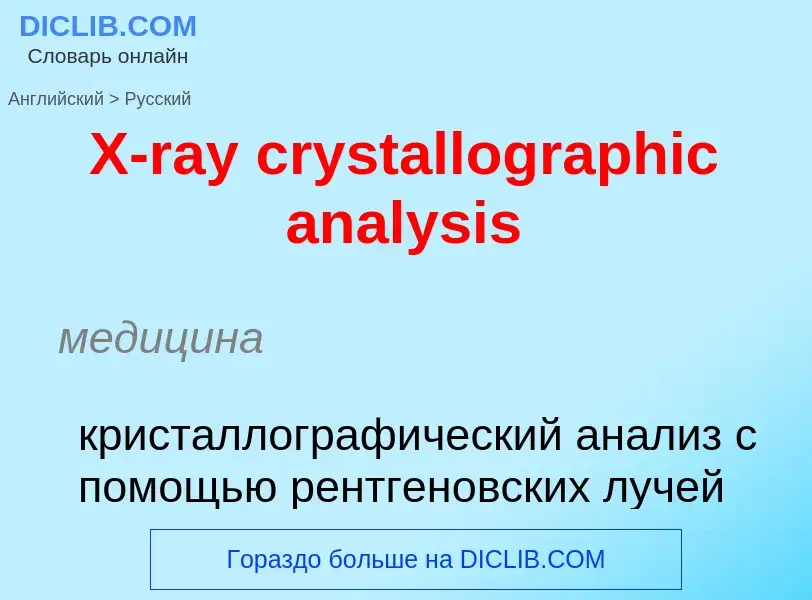Vertaling en analyse van woorden door kunstmatige intelligentie
Op deze pagina kunt u een gedetailleerde analyse krijgen van een woord of zin, geproduceerd met behulp van de beste kunstmatige intelligentietechnologie tot nu toe:
- hoe het woord wordt gebruikt
- gebruiksfrequentie
- het wordt vaker gebruikt in mondelinge of schriftelijke toespraken
- opties voor woordvertaling
- Gebruiksvoorbeelden (meerdere zinnen met vertaling)
- etymologie
X-ray crystallographic analysis - vertaling naar russisch
медицина
кристаллографический анализ с помощью рентгеновских лучей
общая лексика
рентгеноструктурный анализ
строительное дело
рентгенографический дифракционный анализ (грунта)
Definitie
Wikipedia

X-ray crystallography is the experimental science determining the atomic and molecular structure of a crystal, in which the crystalline structure causes a beam of incident X-rays to diffract into many specific directions. By measuring the angles and intensities of these diffracted beams, a crystallographer can produce a three-dimensional picture of the density of electrons within the crystal. From this electron density, the mean positions of the atoms in the crystal can be determined, as well as their chemical bonds, their crystallographic disorder, and various other information.
Since many materials can form crystals—such as salts, metals, minerals, semiconductors, as well as various inorganic, organic, and biological molecules—X-ray crystallography has been fundamental in the development of many scientific fields. In its first decades of use, this method determined the size of atoms, the lengths and types of chemical bonds, and the atomic-scale differences among various materials, especially minerals and alloys. The method also revealed the structure and function of many biological molecules, including vitamins, drugs, proteins and nucleic acids such as DNA. X-ray crystallography is still the primary method for characterizing the atomic structure of new materials and in discerning materials that appear similar by other experiments. X-ray crystal structures can also account for unusual electronic or elastic properties of a material, shed light on chemical interactions and processes, or serve as the basis for designing pharmaceuticals against diseases.
In a single-crystal X-ray diffraction measurement, a crystal is mounted on a goniometer. The goniometer is used to position the crystal at selected orientations. The crystal is illuminated with a finely focused monochromatic beam of X-rays, producing a diffraction pattern of regularly spaced spots known as reflections. The two-dimensional images taken at different orientations are converted into a three-dimensional model of the density of electrons within the crystal using the mathematical method of Fourier transforms, combined with chemical data known for the sample. Poor resolution (fuzziness) or even errors may result if the crystals are too small, or not uniform enough in their internal makeup.
X-ray crystallography is related to several other methods for determining atomic structures. Similar diffraction patterns can be produced by scattering electrons or neutrons, and neutron scattering can be similarly interpreted by Fourier transformation. If single crystals of sufficient size cannot be obtained, various other X-ray methods can be applied to obtain less detailed information; such methods include fiber diffraction, powder diffraction and (if the sample is not crystallized) small-angle X-ray scattering (SAXS). If the material under investigation is only available in the form of nanocrystalline powders or suffers from poor crystallinity, the methods of electron diffraction, transmission electron microscopy and electron crystallography can be applied for determining the atomic structure.
For all above mentioned X-ray diffraction methods, the scattering is elastic; the scattered X-rays have the same wavelength as the incoming X-ray. By contrast, inelastic X-ray scattering methods are useful in studying excitations of the sample such as plasmons, crystal-field and orbital excitations, magnons, and phonons, rather than the distribution of its atoms.


![tetrahedrally]] and held together by single [[covalent bond]]s, making it strong in all directions. By contrast, graphite is composed of stacked sheets. Within the sheet, the bonding is covalent and has hexagonal symmetry, but there are no covalent bonds between the sheets, making graphite easy to cleave into flakes. tetrahedrally]] and held together by single [[covalent bond]]s, making it strong in all directions. By contrast, graphite is composed of stacked sheets. Within the sheet, the bonding is covalent and has hexagonal symmetry, but there are no covalent bonds between the sheets, making graphite easy to cleave into flakes.](https://commons.wikimedia.org/wiki/Special:FilePath/Diamond and graphite2.jpg?width=200)


![backbone]] from its N-terminus to its C-terminus. backbone]] from its N-terminus to its C-terminus.](https://commons.wikimedia.org/wiki/Special:FilePath/Myoglobin.png?width=200)
![Rocknest]]", October 17, 2012).<ref name="NASA-20121030" /> Rocknest]]", October 17, 2012).<ref name="NASA-20121030" />](https://commons.wikimedia.org/wiki/Special:FilePath/PIA16217-MarsCuriosityRover-1stXRayView-20121017.jpg?width=200)
![A protein crystal seen under a [[microscope]]. Crystals used in X-ray crystallography may be smaller than a millimeter across. A protein crystal seen under a [[microscope]]. Crystals used in X-ray crystallography may be smaller than a millimeter across.](https://commons.wikimedia.org/wiki/Special:FilePath/Protein crystal.jpg?width=200)


